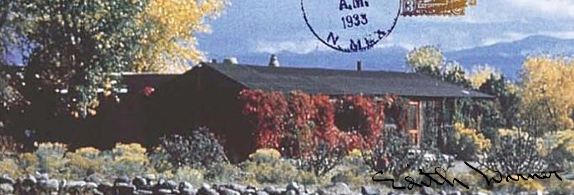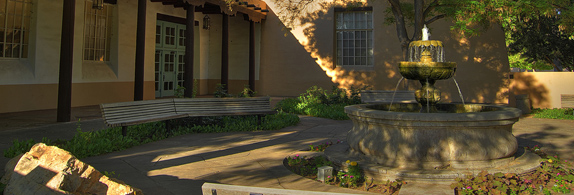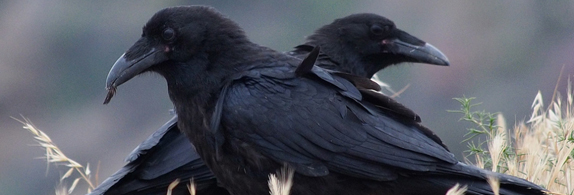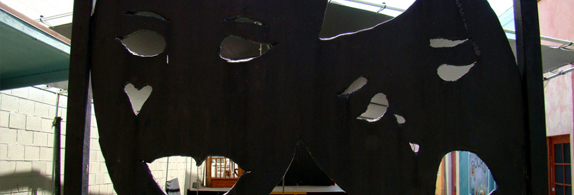Edith Warner in the Shadow of Los Alamos

Edith Warner had New Mexico in her soul. She loved it so much and spoke of its spirit with such respect and tenderness that she gives it back to us with an added radiance and meaning.
As she wrote in her journals in l933, “What we do anywhere matters, but especially here. It matters very much. Mesas and mountains, rivers and trees, winds and rain, are as sensitive to the actions and thoughts of humans as we are to their forces. They take into themselves what we give off, and give it out again.”
Edith Warner is a famous New Mexican, and famous in a way that can only happen here. She’s the subject to two famous books, one a biography by Peggy Pond Church called The House at Otowi Bridge, and the other a novel by Frank Waters, The Woman at Otowi Crossing. But famous though she is, as it goes around here, hardly anyone’s heard of her.
In 2001 UNM Press brought out a marvelous collection of essays and other writings edited by Patrick Burns named after the title of her unfinished autobiography In the Shadow of Los Alamos. I thought at the time that it was one of the best New Mexican books I’d read. UNM Press has brought out this year a paperback edition of this classic. And I’m reading it again with more interest and delight than ever.
Edith Warner owned a tea room near the Rio Grande where the Otowi gauge measures the river’s flow. The teashop was also at the bottom of the road that lead to Los Alamos during the Manhattan Project and was a close neighbor to San Ildefonso Pueblo and the Espanola Valley where she had many close friends. The world’s top physicists escaped to her little refuge where she cooked them supper, gave them the comfort of her attention, and fed them her coveted chocolate cake.
It was probably in early 1943 that Robert Oppenheimer, who directed the Manhattan Project, and other scientists first came to the tea room. In her annual Christmas letter in l943, she referred to them as the “X’s,”: saying, “one or two groups of them are there most nights for dinner. They come in through the kitchen door, talk a bit before leaving, and are booked up weeks ahead. Because they are isolated and need even this change for morale, I feel it is definitely a war job for me.”
And the war was never far from her awareness.
In her l946 Christmas letter she wrote, “Today we gathered the Christmas greens. Large Los Alamos signs bar the canyons where we formerly found fir…. Most of the men whose knowledge made atomic bombs possible have returned to laboratories and universities to do research, to teach future scientists, to try to solve the world atomic problem. But others have come to continue work on atomic weapons and other uses of the energy. So louder and louder blasts echo over the Plateau and my blood runs cold remembering Hiroshima. If the world lived here, all would be reminded frequently that we must catch up with striding science and find a way to live together in the peace that Christmas signifies.”
Warner died from leukemia in May l951 at age 57. Was she an early downwind victim of Los Alamos testing? We’ll never know. A year before her death she wrote at Christmas, “How to endure the manmade devastating period in which we live and which seems almost as hopeless to control as drought; how to proceed when leadership seems utterly lacking, when individuals and nations seem stupid and arrogant; these no one human can answer. I only know that the power recognized by those other sky scanners still exists, that contact is possible. I know, too, what depths of kindness and selflessness exist in my fellow man.”
“When Tilano (her old friend from the Pueblo) lights the Christmas Eve fire, perhaps against a white hillside, I shall watch from the house where some have felt peace and hope that in our sky there are some bright stars.”
Of Edith Warner’s published essays, one stands out for me. It is entitled “Relaxing for Health” and was published in June 1925. “Could there be a more vicious circle,” she wrote, “as far as health is concerned, than wrong food combinations, tense bodies, whirling brains? It would be time well spent if, from half an hour of watching the public eat lunch, one realized how the majority live, and begin to look for similar evidences of tension in oneself.”
“Days are too short for all the work, the reading, the exercise, the recreation, that we Americans want to accomplish; so we spend them dashing through all that possibly can be done; fretting and fuming about the things for which we have no time; hurrying to bed and to sleep – in order to be ready for another day – without relaxing out of that whirl. What is the result? We go from one physician to another, we endure innumerable treatments; we spend months and money in all sort of hospitals and sanitariums. Few, if any, of those to whom we go for relief and guidance tell us how to live.”
She advised people to cultivate relaxation and to learn what it means to them. “When the mind is a whirl of circling thoughts, think of some quiet scene – a mirror-like lake, the skyline of a mountain range, the hush of a deep canyon. Relax until it has become a habit.
“These are but glimpses into a quiet land – hints of how one may gain entrance to it. Beyond are health and happiness – when one has learned how really to live.”
Edith Warner came to New Mexico in l922 to find peace of mind and a place where she could live with integrity and purpose. The New Mexican land and its people gave her an understanding of how to live a good life and share its treasures with others.
Great cosmic forces were never far from her inner life. In a journal entry from February l935 she wrote “On Grey days like this I so often think of wild geese flying south….Now above, now below, the broken mesa rim they flew, with never a moment of hesitation, with always the memory of warm, plentiful feeding grounds, and an old trail to them. Where the river turns again, they rose above the mesa, and my last glimpse was that swaying line against lighter clouds, winging southward. Death could be like that.”
For many of us Edith Warner remains a wise guide whose reassuring voice we can hear just over the next hill, urging us to catch up and walk free with her through piñon and juniper woodlands, and up and over far hills of our own.
UNM As a Walking Environment

Except for its parks and irrigation ditches, Albuquerque isn’t a great walking environment. It’s even hard to cross many big streets, the traffic signals being set for cars and sprinters, not strollers. Trying to cross San Mateo and Montgomery, for instance, or Louisiana near Uptown and Coronado, is like being caught in a video game full of crazy omnivorous race cars.
But then there’s the central campus of the University of New Mexico. It’s a bucolic little city of its own, stretching from University to Girard and Central to Lomas. This is an urban environment that was designed specifically for walking by generations of university planners and architects. The contrast between the rest of our car bedeviled town and UNM is stark. One moment you’re in fear for your life, the next you’re in a pedestrian oasis, a place actually designed for human beings, not for cars.
I’ve gone to walk and think there most weekdays for more than 50 years. Not only is the central campus an architectural museum, it is also an urban forest. And UNM’s gardeners and groundskeepers are dedicated to nurturing a peaceful space for students and faculty. And for visitors too. Shady benches, secret byways, beautiful little detours are everywhere you go, if you’re looking for them. You can easily walk for an hour without repeating a step. The central duck pond, John Gaw Meem’s Scholes Hall and Zimmerman Library, all have side paths and secluded rest areas. Walking in Zimmerman Library, spending time with its murals and in its great, church-like reading rooms is one of New Mexico’s great experiences. And the Sandia Mountains seen from the fourth floor windows of the Fine Arts Library in George Pearl Hall can open the mind of even most fatigued and harried student of life.
Being a New Mexican, now, for 55 years, I’ve long thought that the central campus’ unique mixture of Spanish Pueblo Revival Style buildings lingering from the l930s and 40s, combined with New Mexico modernism, make for one of the most beautiful regional design campuses in the country, due in large measure to retired University Architect Van Dorn Hooker’s influence over the years. He insisted that that a regional style could also be modernist, and that a design code that reflected the geological and cultural realities of the state wasn’t something phony or, as some internationalists call it, “faux adobe.”
The campus has great museums to visit as well, the largest library in the state, fascinating biological holdings in its hothouses, and an environment of amenities with many places to eat and get coffee, including the UNM Bookstore. It also has many quiet places to read and reflect. One could make a week of walks going through the Fine Arts Museum, the Geology Museum, and the Maxwell Museum of Anthropology.
What pulls me to the campus the most, aside from a museum of memories in my head, is the sense of the inevitable, but common and gentle passage of change embodied in the buildings, change that moves from the New Mexican landscape through ancient and rural New Mexico cultures, to the modern world of scientific and engineering innovation that flows through our state every day like an enormous invisible tide.
Every chance I get on our travels, I walk through other college campuses. They are always full of beautiful sights and gentle adventures. But none are better than our university’s. For a New Mexican not to take advantage now and then of the largely secret joys and pleasures of UNM’s central campus is to miss a public triumph of comforting calm and inspiring sense of place.
Critters We Have Known: An Unkindness of Ravens and Other Corvids

I’ve been fascinated by ravens since I first saw them sailing the cliffs in Chaco Canyon more than four decades ago. I watch for them and for their shadows gliding over the landscape every time I’m there. I wear a ball cap with a raven on it from Chaco.
Ravens belong to a family of birds known for their high intelligence and, I’m even tempted to say, their imaginations. They’re called corvids. And among the more than 120 species worldwide are crows, ravens, jays, and magpies, all birds we know well in New Mexico.
Ravens and crows have something of a mythological presence. They are associated with tricksters, healers, pathfinders, jokers, and agents of change. And in some parts of the world they are the subject of curious superstitions. We have a friend in England who thinks it’s bad luck not to salute magpies when you see them. We’ve taken up the practice ourselves.
Once in a trading post in Northern New Mexico about forty years ago, I saw on a high shelf what seemed to be a line of stuffed crows, with white cotton in their eyes. I asked to see one, and was handed a little mummy like bundle from under the counter swaddled in Chinese newspapers, imported apparently from Taiwan for “ceremonial purposes in the pueblos,” I was told. I bought one, of course, and it’s still in my office overseeing the proceedings from another high shelf. To soften the impact of its seemingly sinister appearance, we long ago named it J.C. Willet.
Years earlier I was passing the petting zoo in the Albuquerque Zoological Park. There, in a caged-in area, was a raven standing and watching the sky. He was looking up at other ravens, or crows, flying overhead. He seemed puzzled, irritated, lonely. He knew he was not free. I remember thinking to myself that it was the saddest thing I’d seen in the animal world. And when I began to understand the intelligence of ravens, it makes his captivity more troubling even in the hindsight of decades.
Corvids in general, have “body-to-brain weight ratios” that are among the “largest in birds, equal to that of most great apes and cetaceans, and only slightly lower than humans.” When compared to dogs and cats at finding food, “corvids out-performed the mammals…” The Eurasian Magpie is the “only non-mammal species known to be able to recognize itself in a mirror test.”
Several years ago at UNM, a huge “murder” of crows swarmed and cawed among the tops of the big conifers on the main campus. They were almost enough to darken the sky. And they left their leavings, to be delicate, all over everywhere, including on the path to the president’s house. It was like having a hive of bats on campus, the crows moved in such thick mobs.
I’m not sure how, but perhaps by presidential decree, the crows were dissuaded from “murdering” on campus. And one day, the magnificence of the feathered clattering of their wings had vanished.
Ravens and crows have attracted the whimsy of poets. A flock of crows, for instance, is known as a “murder,” or, in some circles as a “parcel.” And although ravens don’t tend to flock, a group of them are known variously as “a constable,” or “an unkindness,” or a “conspiracy.”
Perhaps the raven caged in the zoo felt the black birds overhead were an unnecessary “unkindness” and wished they would stop reminding him of his captivity and just leave him alone.
New Mexico Civility

It doesn’t take much to get a smile in New Mexico, if you’re not behind the wheel of a car.
One of our state’s greatest and least mentioned virtues is the kindness, hospitality, and general conviviality of our citizens. The farther north you go, the ever more cordial folks become.
Give a smile, you get a smile back, north, south, east, or west. Ask how a complete stranger is, and if they’re New Mexicans, they’ll invariably say something like “Good, and you?” I do it myself after 55 years here.
The “and you” is more than a formality, more really than even a courtesy. It signifies. I think, that New Mexicans know they live in the world of other people, and that other people are important and not to be dismissed. It’s a deep seated sense of community and an expression of what makes a community thrive – acts of kindness and consideration woven into the fabric of our days.
Why does that communitarian civility vanish the moment almost anyone gets into their car and starts driving here? Rudeness, impatience, volatility rule the day. Is it just a guy thing? Mostly, I guess. But not exclusively.
Give a dark glance in the wrong direction, mutter to yourself visibly at a stop light, or, god forbid, move ahead of someone a smidgeon too tightly, and all hell could break loose.
I remember driving down Girard one hot afternoon when a truck passed me with the driver throwing me the finger, glowering with all the hate one might reserve for a conquering army. Had I been driving too slowly? Were my bumper stickers of the wrong political persuasion? Who knows? I did respond, though, with very foolish impulses I had to work hard to suppress.
But I do know this as well, that in a grocery store, or a sporting goods store, or some other public place, chances are the finger thrower would have said “sorry” had he bumped into me and because I’m white-haired, he might have even the held the door open for me.
What gives? Is it the machine itself? Too much power corrupting some folks absolutely? Is it out-of-staters in our midst?
I think I’ll keep my idealism intact by forgetting cars and their angry drivers and remembering instead the endless kindnesses and cheerfulness I’ve known in the community of those who walk in a world where other people matter.
(Creative Commons images via Flickr. Zimmerman Library by Imran Mansuri, Ravens by Ingrid Taylar, Smile Now Cry Later by vmiramontes.)

August 19, 2013